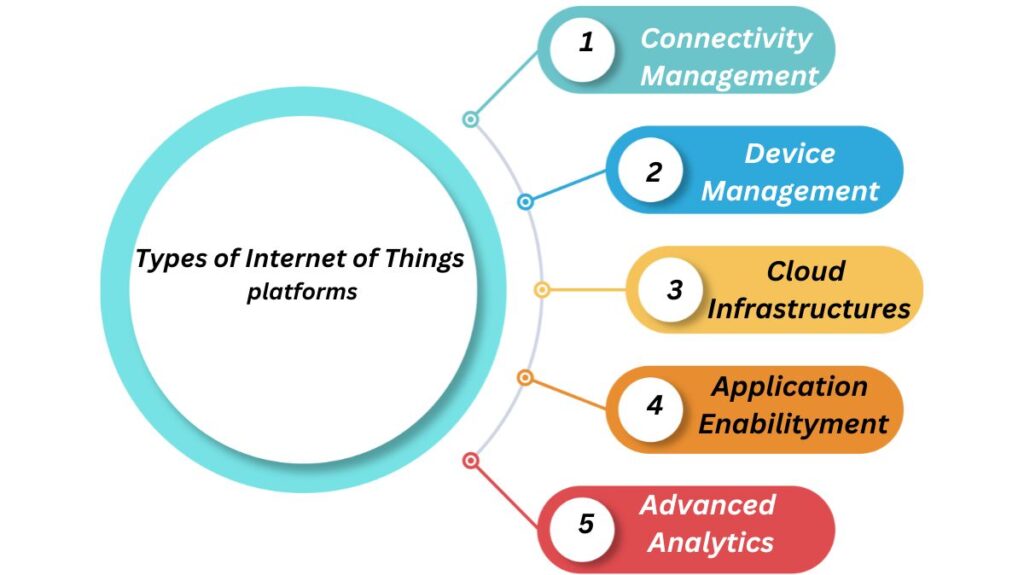Learn about types of IoT platforms, including device management, connectivity, data analytics, and security solutions, for seamless IoT operations.
Hardware, software, the user interface, and the network are the four main parts of Internet of Things systems. Imagine, for instance, that you have a vast army of Internet of Things robots. The robots and their sensors make up the hardware, the software instructs them on how to march in unison, a network facilitates communication between them and you, and the user interface determines which direction to march in.
The challenge in overseeing an Internet of Things system such as this army of robots is that its four constituent parts are interdependent but autonomously controlled. These four components are not under the supervision of a single system that would make sure they are interacting as intended, check for problems with your bots, or organise the data being collected.
The four elements are joined by an Internet of Things platform to produce a coherent, controllable, and comprehensible system. These platforms aid in creating a seamless, cohesive process for data ingestion, communication, device management, and application operations.
Additionally, instead of starting from scratch to build your robot army, Internet of Things platforms provide a foundation upon which you may grow. It speeds up, simplifies, and greatly increases the usefulness of designing an Internet of Things system.
In other words, it serves as the link between Point A, which is a brilliant idea, and Point B, which is a realised notion.
Types Of IoT Platforms

Internet of Things platforms can be divided into five categories:
Internet of Things Platforms for Connectivity Management
As the name implies, Internet of Things Connectivity Management platforms are focused on the networking aspect of Internet of Things devices. They give consumers the data directing, connectivity hardware, and software they need to keep their devices online. Their networks typically use Wi-Fi and carrier services that are already in place, setting up the link to make Internet of Things deployment simple.
Device Management Platforms for Internet of Things
IoT Device management platforms are experts at the tedious tasks associated with Internet of Things devices. They keep you informed about the condition of your equipment and guarantee that everything is safe and linked. Device management solutions patch security, report metrics, upgrade firmware, and alert you to changes in your devices. Regardless of how many devices you have, this type of Internet of Things platform will assist you with the daily chores related to them.
Internet of Things Cloud Infrastructures
Internet of Things Cloud platforms give consumers access to the infrastructure needed to build an integrated Internet of Things solution. They serve as the hub for all of your backend data and operations. Scalability is a major advantage of cloud platforms; no matter how short you start, a cloud platform can expand with you and your Internet of Things system.
Platforms for IoT Application Enabilityment
One-size-fits-all IoT application enablement systems give consumers all the tools they need to launch an IoT system. They offer you the hardware, software, Internet of Things system development, and implementation. They are a one-stop shop for system kickstarting, saving you the trouble of managing hardware engineering, network configuration, and developers.
Advanced Analytics Platforms for the Internet of Things
IoT Data-driven Internet of Things systems can benefit greatly from advanced analytics tools. Such a platform can be used by users seeking advanced IoT systems that use statistical modelling, machine learning, artificial intelligence, and mass data gathering to analyse and act on the collected data. These platforms will be most useful for Internet of Things devices that primarily function as data ingesters rather than task performers.
Crucial Factors to Take Into Account While Selecting an Internet of Things Platform
When starting, choosing the appropriate IoT platform is crucial. Making the switch to an Internet of Things platform will be more expensive and difficult the larger your IoT system grows. Not only must you choose the platform that best meets your demands, but it must also have the dependability and service to assist you in the long run.
Apart from selecting the kind of platform that best meets your requirements, security, dependability, and usability are the most crucial factors to take into account when choosing an IoT platform. Your Internet of Things system should be simplified by an Internet of Things platform into a manageable, intelligible entity. Since your IoT system will be collecting and sending countless amounts of data about your business, security is also essential. Finally, dependability. Selecting a less costly IoT platform might save you money in the short run, but millions of devices will suffer if their service is poor.
Conclusion
You may require multiple Internet of Things platforms to maintain the functionality of your system, depending on its complexity. A large Internet of Things system can avoid becoming overloaded by using a connectivity management tool to keep your devices available and a sophisticated analytics platform to consume the data you collect.
